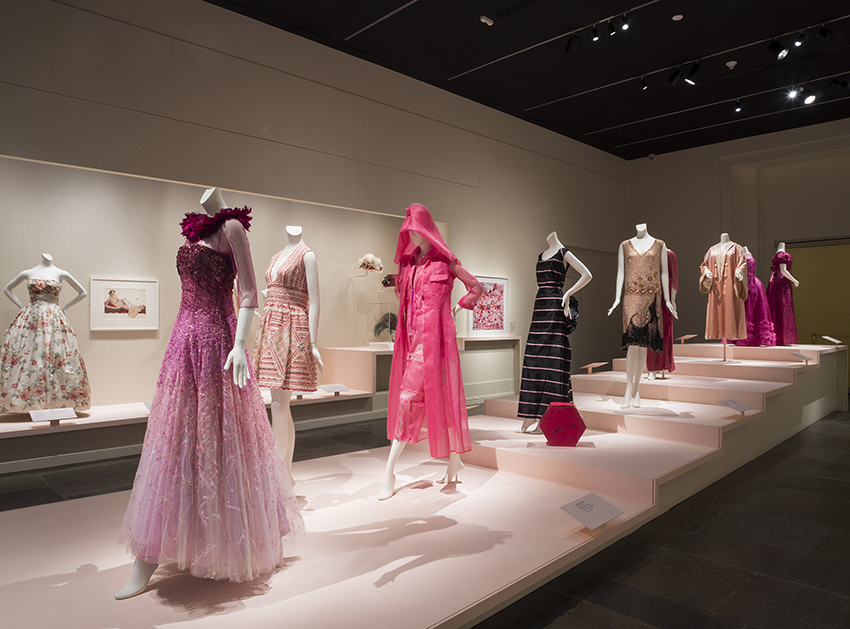MFA’s “Think Pink” Exhibit Explores the History and Meaning of the Color Pink

“Think Pink” at the Museum of Fine Arts, Boston. (Courtesy of MFA Boston)
The color pink and femininity go hand in hand. No questions asked.
But that’s exactly what the new exhibit at the Museum of Fine Arts, titled “Think Pink,” wants viewers to do—to question and explore the history of the color and consider its meaning. Just why do we so firmly associate pink with the female gender?
The exhibit, which opens at the MFA today, encompasses a variety of objects from the museum’s permanent collections, as well as new acquisitions from the wardrobe of late philanthropist Evelyn Lauder, who is credited with establishing the pink ribbon as a symbol for breast cancer awareness.
Inspiration for the exhibit came to the MFA’s Curator of Fashion Arts, Michelle Finamore, as she was sorting through Lauder’s collection, which includes a number of pink dresses worn at charity events.
“I started thinking about it as a nice way to highlight the acquisition of clothing from her collection and also to think about pink more generally and delve deeper into the history of the color,” said Finamore in a phone interview last week. “For us, the associations are so strong—we think of it as such a feminine color. I was thinking, ‘Okay, when does this begin? When in history does this happen?'”
Fascinated with the subject, Finamore looked through the museum’s permanent collections and found plenty of objects that could tell the history of the color—primarily fashion, but also postcards from the Department of Prints, Drawings, and Photographs and works from the Art of the Americas collection—through an interdisciplinary look.
The “Think Pink” exhibit, housed in the MFA’s Loring Gallery, follows a chronological order, dating back to the color’s origin in the late 17th century and progressing through its boost in popularity in the 1830s, advances in artificial dye technology in the 1850s, and finally, exploration of the color’s association with femininity.
“It’s a one-gallery show, so I was trying to address different themes, but keep it relatively concise,” said Finamore. “It was a bit challenging, but hopefully it works.”
As a number of objects come from Lauder’s collection, Finamore planned the exhibit for October, to coincide with National Breast Cancer Awareness Month. To honor the association, the MFA building will be lit up in pink for the remainder of the month.

The MFA will be illuminated in pink for the month of October. (Courtesy of MFA Boston)
Among Finamore’s favorites in the exhibit are pieces from the museum’s permanent collections that have never been exhibited before, including an Elsa Schiaparelli bustle skirt from the 1940s and a couture rose-patterned Christian Dior dress, designed by Dior himself at the height of the house’s fame in the 1950s.
Another highlight from the exhibit is a suit worn by famed British fashion journalist Hamish Bowles at a party celebrating his 50th birthday and 21st anniversary working for Vogue. The piece is a custom replica of the pink suit worn by Robert Redford in the original Great Gastby movie.
“There’s this great reference in The Great Gatsby where they say, ‘An Oxford man! […] Like hell he is! He wears a pink suit.’ That’s still in the 1920s and there’s this idea that it’s not really appropriate wear,” said Finamore. “I’m comparing it with an 18th century man’s suit […] with pink floral embroidery. In the 18th century, there were no associations like we have today. Men wore pink and it wasn’t considered a woman’s color.”
Through her research for the exhibit, Finamore found that the association of pink with femininity is a relatively new idea.
“It’s not really until later 1920s, early 1930s that it starts being considered a more feminine color—or at least a more strongly feminine color. In the post-World War II era is when it becomes much more firmly associated with women,” she said. “When men came back from the war, there was a turning back to the traditional feminine and masculine roles because there was this desire to return to what was considered normal life after all the disruption of the war.”
But Finamore believes that pieces like the Hamish Bowles suit embody a shift in thinking.
“There’s a lot more fluidity in terms of gender definition these days. At least in what I see coming down the runway in menswear, there’s so much more in terms of color and creativity and I think that will eventually have an effect and filter down,” she said. “There are plenty of men who wear pink shirts—that’s not unusual. There aren’t many who would wear a full pink suit. Again, it’s probably primarily a high-fashion, urban kind of look, but the way it works, it’ll gradually filter down and I think we’ll see more of an impact in mass-produced fashion.”
“Think Pink” comes on the heels of the MFA’s record-breaking “Hippie Chic” exhibit, responding to the public’s growing interest in fashion.
“Fashion exhibits are on the rise and while it’s taken a bit of time for that appreciation to grow, I think it’s finally here and that’s really quite satisfying, finally getting to that point where it’s considered of the same caliber as some of the other objects and paintings in the museum,” said Finamore. “It’s a great way to draw people in and get them interested and have them realize how much more is actually happening [in other galleries of the museums] as well.”
“Think Pink” will be on view in the Loring Gallery at the Museum of Fine Arts, 465 Huntington Ave., from October 3, 2013, to May 26, 2014. For more information visit mfa.org.


